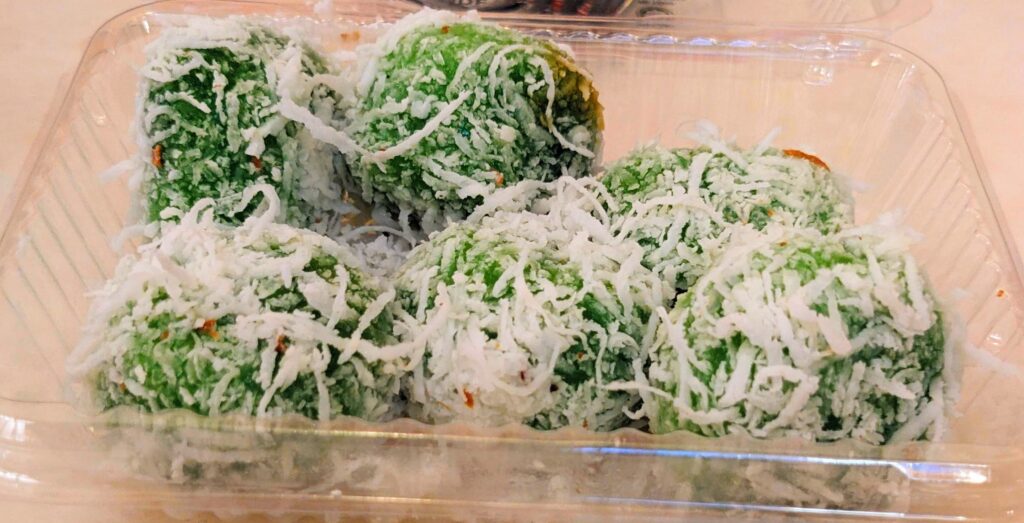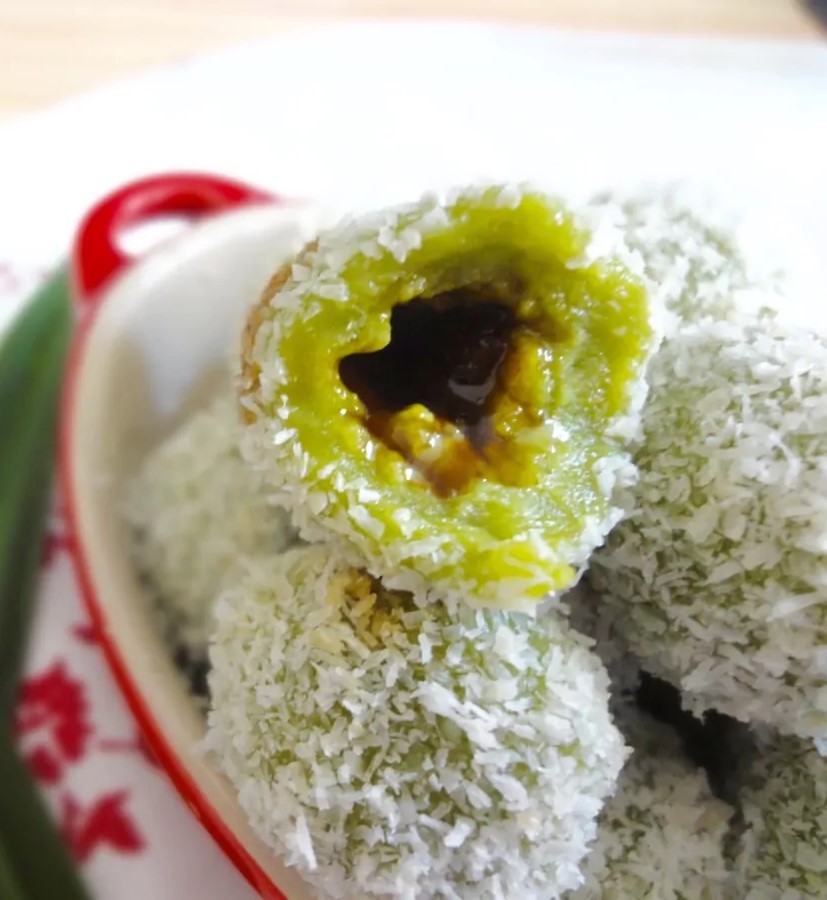Ondeh Ondeh
Ondeh-Ondeh or Klepon? A Sweet Treat with Many Names but One Unforgettable Taste!
Fact File
Name:
Origin:
Popular in:
Complexity:
Flavor Profile:
Notable Ingredients:
Popularity:
Ondeh-Ondeh/Onde-Onde/Klepon/Buah Melaka
Java
Java and nearby islands as well as Baba Nyonya communities in Malaysia
Easy
Sweet
Gula Melaka, Pandan,Coconut
Popular in homes and food stalls
Ondeh-Ondeh (Klepon)
Languages has its way to confuse things sometimes. This sweet, green, glutinous rice kuih has a variety of names in South East Asia, and depending who you speak to, may think you are talking about something completely different! It is known in Java as Klepon and in Malay as Onde-Onde or Ondeh-Ondeh (old Malay spelling), interchangeably. The confusion arises with the fact that Indonesia has another popular street snack called Onde-Onde which is more widely known as Jian Dui – a sesame ball filled with red bean or other bean pastes. This is known as Kuih Bom in Malay, with its crispy exterior encasing the hot filling inside to explode in your mouth like a bomb.
Interestingly the Kuih Bom can sometimes have sweet, shredded coconut or nuts, adding a local take on the Chinese snack. Jian Dui is widely popular across East and South East Asia. However, this article is about the Ondeh-Ondeh, or Klepon. If you forget what to call it, you won’t forget the taste!

Ondeh-Ondeh is made by mixing together glutinous rice flour with salt. The pandan element is then added which gives the kuih its green color. Different places will use different pandan elements – pandan juice, pandan paste or pandan-suji paste. The sticky dough will then be formed. Then you would simply make small balls out of the dough, flatten it and add the shaved palm sugar inside encasing it inside. Then the balls are instantly put into boiling water for a minute for the sugar to melt. Once they are dried, the balls are coated in the grated coconut and the Onde-Onde/Klepon is formed.
Ondeh-Ondeh or Klepon, most likely date back centuries since the ingredients and cooking methods are all local and traditionally found in the archipelago. Ingredients such as palm sugar, grated coconut and rice flour are in fact native to South East Asian, making it a completely colonial-free kuih!
Evidence of Klepon exist in the Serat Centhini, a 12-volumne manuscript commisioned by Pakubuwono V of Surakartaone in order to document the physical and spritual knowledge of Javanese people. It mentions the Klepon as one of the dishes seen in royal banquets and celebrations (p. 609, verse 8-12). This is one of the very few written pieces of evidence of Klepon as most of the history was only brought orally through generations. So can it be said, for certain, that Ondeh-Ondeh is originally Javanese? No, but it is highly likely. It is very likely that the Klepon grew in popularity from Java across Indonesia, singapore and Malaysia. In Malaysia, it was adopted by the Malay and Peranakan communities with sometimes using sweet potato instead of glutinous rice flour. It is also possible that different people across the archipelago may have created recipes resembling Ondeh-Ondeh without properly documenting it due to how abundant the ingredients are in the region.
In the end, the journey of Ondeh-Ondeh (or Klepon, depending on where you’re from) is a rich and complex one, steeped in centuries of tradition and cultural exchange. Despite the confusion surrounding its many names, one thing remains certain: its delightful taste transcends borders. Whether it’s the soft, chewy exterior made from glutinous rice or the burst of sweet, aromatic palm sugar filling, this beloved kuih is a testament to the simple yet profound pleasures of Southeast Asian cuisine. As with many foods that have deep roots in the archipelago history, its true origins remain a mystery—but what matters most is how it continues to bring joy to people across the region. So, no matter where you are, if you get a chance to enjoy Ondeh-Ondeh, savor it for what it truly is: a kuih, literally bursting with flavor that made it through colonialism, still intact.
Some Authentic Recipes to Learn From
- Klepon (Pandan Glutinous Rice Balls with Palm Sugar Filling) – Jaja Bakes
- Onde Onde Recipe (with Sweet Potato)
- Viral Klepon ‘Tidak Islami’, Klepon Sudah Disebut Dalam Serat Centhini
- Asal-usul dan Makna Filosofis Klepon
- Sejarah Klepon, Kue Tradisional yang Tak Hanya Ada di Jawa Halaman all – Kompas.com
- Nava’s Zen: Kuih Buah Melaka
- 20 Best Desserts in Indonesia – TasteAtlas
- Exploring the History of Onde-Onde You Should Know – PONDAN | Kreasi Pondan Foods
- History of Klepon & Ondeh Ondeh · 1000 Year Old Sweet |Tony Johor Kaki Travels for Food · Heritage · Culture · History
- The stirring story of how rich, sweet palm sugar is made | SBS Food


